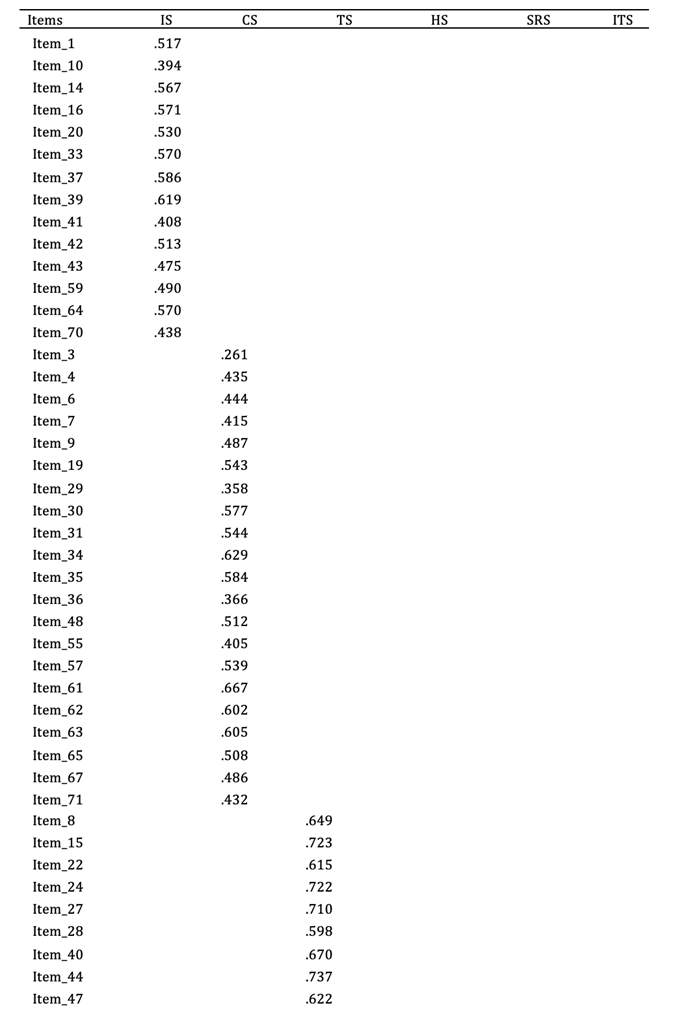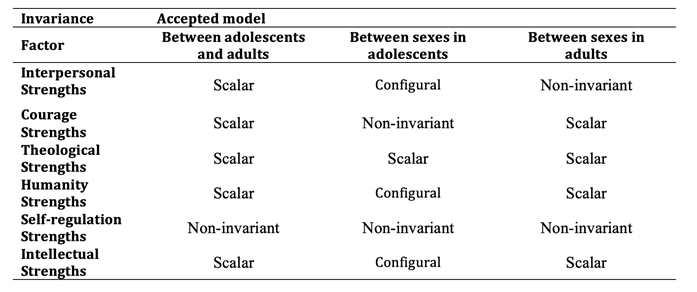Servicios Personalizados
Revista
Articulo
Links relacionados
Compartir
Ciencias Psicológicas
versión impresa ISSN 1688-4094versión On-line ISSN 1688-4221
Cienc. Psicol. vol.18 no.1 Montevideo 2024 Epub 01-Jun-2024
https://doi.org/10.22235/cp.v18i1.3297
Original Articles
Character Strengths Scale: new validity evidence
1 Programa de Pós-Graduação Stricto Sensu em Psicologia, Universidade São Francisco, Brasil, rafamoreton@hotmail.com
2 Programa de Pós-Graduação Stricto Sensu em Psicologia, Universidade São Francisco, Brasil
3 Programa de Pós-Graduação Stricto Sensu em Psicologia, Universidade São Francisco, Brasil
4 Programa de Pós-Graduação Stricto Sensu em Psicologia, Universidade São Francisco, Brasil
The aim of the study was to identify instruments used to assess the Character strengths are considered a positive aspect of personality, indicating a satisfying and authentic life. The Character Strengths Scale is the only known measure that evaluates personal strengths of Brazilians. The literature suggests that the proposed structure of 24 character strengths divided into six virtues is not empirically replicated. Studies have compared character strengths between men and women and across stages of development; however, understanding the equivalence of the instrument across groups should precede such comparisons. This study aims to test the factor structure of the Character Strengths Scale found by Noronha and Batista (2020) and evaluate the construct’s invariance among adolescents and adults, as well as between sexes in adolescents and adults. For the first objective, Confirmatory Factor Analysis (CFA) was employed, which supported the tested structure. For the second, the equivalence of the scale factors between groups was evaluated using Multi-Group CFA, which identified some factors as equivalent and others as not. It can be concluded that the tested factor structure is empirically relevant and that, when comparing strength means between groups in future studies using the Character Strengths Scale, authors should pay attention to which strengths belong to invariant factors.
Keywords: psychological assessment; psychometrics; positive psychology; personality.
As forças pessoais são consideradas como construto da personalidade com aspecto positivo, indicando uma vida satisfatória e autêntica. A Escala de Forças de Caráter (EFC) é a única que se tem conhecimento que avalia as forças pessoais dos brasileiros. A literatura aponta que a estrutura proposta, das 24 forças pessoais divididas em 6 virtudes, não é replicada empiricamente. Estudos tem comparado as forças de caráter entre homens e mulheres e entre etapas do desenvolvimento, porém, compreender a equivalência do instrumento entre os grupos deve preceder tais comparações. Este estudo objetiva testar a estrutura fatorial da EFC encontrada por Noronha e Batista (2020) e avaliar a invariância do construto entre: adolescentes e adultos, sexo em adolescentes, sexo em adultos. Para o primeiro objetivo, empregou-se uma Análise Fatorial Confirmatória (AFC), que corroborou a estrutura testada. Para o segundo, avaliou-se a invariância dos fatores da escala entre os grupos a partir da AFC-Multigrupo, que apontou alguns fatores como equivalentes e outros não. Pode-se concluir que a estrutura fatorial testada é empiricamente pertinente e que, ao comparar médias das forças entre os grupos em estudos futuros com a EFC, os autores devem se atentar a quais forças pertencem a fatores invariantes.
Palavras-chave: avaliação psicológica; psicometria; psicologia positiva; personalidade
Las fortalezas del carácter se consideran un aspecto positivo de la personalidad que indica una vida satisfactoria y auténtica. La Escala de Fortalezas del Carácter (EFC) es la única medida conocida que evalúa las fortalezas personales de los brasileños. La literatura sugiere que la estructura propuesta de 24 fortalezas divididas en seis virtudes no se replica empíricamente. Los estudios han comparado las fortalezas del carácter entre hombres y mujeres, y en diferentes etapas del desarrollo; sin embargo, comprender la equivalencia del instrumento entre grupos debe preceder a tales comparaciones. Este estudio tiene como objetivo probar la estructura factorial de la EFC encontrada por Noronha y Batista (2020) y evaluar la invarianza del constructo entre: adolescentes y adultos, sexo en adolescentes, sexo en adultos. Para el primer objetivo, se utilizó el Análisis Factorial Confirmatorio (CFA) que respaldó la estructura probada. Para el segundo, se evaluó la equivalencia de los factores de la escala entre grupos utilizando el CFA Multigrupo, que identificó algunos factores como equivalentes y otros no. Se puede concluir que la estructura factorial probada es empíricamente relevante y que, al comparar las medias de las fortalezas entre grupos en futuros estudios utilizando la EFC, los autores deben prestar atención a qué fortalezas pertenecen a factores invariantes.
Palabras clave: evaluación psicológica; psicometría; psicología positiva; personalidad
The construct of character strengths has been discussed by Positive Psychology since the 1990s, when a group of researchers organized an initial list of strengths, which formed the basis for a more comprehensive conceptualization of individuals’ positive traits (Noronha & Reppold, 2019; Park, 2009). The researchers employed various resources to obtain the initial list, initially utilizing the retrieval of existing scientific production. Authors Peterson and Seligman (2004), after participating in several conferences and seminars and studying traditions, documents, religious books, and philosophical works, published a comprehensive, internationally recognized material that included 24-character strengths theoretically grouped into six virtues. The book was titled Manual of Sanities, in criticism of the emphasis placed until that moment on the investigation of human pathologies rather than flourishing.
In this way, character strengths can be understood as fundamental positive attributes -positive personality traits- for individuals to lead a fulfilling and happy life (Noronha & Reppold, 2019). Park (2009) further complements this definition by stating them as unique traits that can be expressed through thoughts, actions, and feelings. Recently, Noronha and Reppold (2021) suggested that the most appropriate translation of “character strengths” into Portuguese would be forças pessoais (personal strengths). For this reason, from this moment on, we will use this terminology.
Personal strengths correspond to the healthy aspects of individuals’ personalities, and it is crucial to utilize this psychological construct in practice. They are stable in individuals but susceptible to being intensified and need to be analyzed according to the person’s development and the context in which they are embedded (Reppold et al., 2021). There are intervention research studies related to personal strengths with satisfactory results. In the clinical area, they promote increased self-esteem, happiness, and self-efficacy; in the hospital setting, there has been an improvement in quality of life and treatment adherence; in the school context, personal strengths help improve academic performance and reduce instances of bullying, as well as occurrences of symptoms associated with depressed mood and anxiety; in the family setting, they contribute to understanding family relationships and deepening awareness of the dynamics among its members (Noronha & Reppold, 2019; Reppold et al., 2021). For effective intervention in various contexts with personal strengths, it is necessary to have an instrument with theoretical quality, technical robustness, and scientific validity.
With the publication of the classification of personal strengths, research has been conducted aiming to advance theoretical understandings and empirical evidence of the construct. Consequently, instruments accessing personal strengths were constructed, with the most commonly found in international literature being the Values in Action (VIA; Peterson & Seligman, 2004). The VIA enabled research to be developed in many countries such as South Africa, Croatia, Israel, India, Germany, among others (Noronha et al., 2015). In the Brazilian context, based on the VIA, the Character Strengths Scale (Escala de Forças de Caráter - EFC, in Portuguese) was developed by Noronha and Barbosa (2016). It consists of 71 items that assess the 24 strengths, with the scale containing 3 items for each of them, except for Appreciation of Beauty, which has only 2 items. It is worth noting that the EFC is not an adaptation of the VIA, it’s just used it as a reference.
The EFC is the only scale known to assess personal strengths among Brazilians. There is a Portuguese version of the VIA-IS; however, validity studies conducted by Seibel et al. (2015) identified some weaknesses. In this study, the authors analyzed the factorial structure of the Brazilian Portuguese version of the VIA-IS. Firstly, they used parallel analysis as a method for factor retention, which indicated a solution of three or four factors. Then, they conducted Exploratory Factor Analysis for both possibilities, grouping the items corresponding to each personal strength. However, in both the three-factor and four-factor solutions, several of the personal strengths showed cross-loadings (loadings above .30 on more than one factor). The authors then chose to consider the solution proposed by the Hull method, which, unlike parallel analysis, suggested a unifactorial solution for the VIA-IS, arguing that the strengths would all be interconnected and, therefore, should not be divided into virtues. None of the solutions found support the division of strengths into six virtues, as originally proposed by Peterson and Seligman (2004). In fact, the findings indicate psychometric weaknesses in the results, especially regarding the multifactorial solutions for the scale (Seibel et al., 2015).
Regarding the EFC, several investigations have been conducted to search for validity evidence. Regarding evidence based on internal structure, for example, the authors published three studies, with results differing from one another. The first study, after not finding the theoretical structure of six virtues, proposed a unidimensional interpretation for the EFC (Noronha et al., 2015). The study was conducted with second-order factors, guided by the 24 personal strengths. However, with the advancement of research, it became clear that interpreting a general score of personal strengths had little or no utility. Therefore, the authors tested different structures in two other separate articles. Noronha and Zanon (2018), in a study with a sample of 981 university students, pointed to a three-factor solution for the EFC (Intellect, Intrapersonal, and Collectivism and Transcendence). The authors argued that, despite finding better fit indices in structures tested with a greater number of dimensions, the three-factor solution was the only one that made sense and was theoretically sustainable.
Subsequently, Noronha and Batista (2020), in a study with a sample of 1,500 university students, identified, through Exploratory Factor Analysis, a 6-factor solution for the instrument. However, Peterson and Seligman’s (2004) theoretical classification was not replicated (see Table 1). In this study, several items obtained cross-factor loadings, so the authors proposed allocating them to their respective factors not only based on factor loading but also guided by theoretical aspects. The items were distributed among the following proposed factors: Interpersonal Strengths (IS); Courage Strengths (CS); Theological Strengths (TS); Humanity Strengths (HS); Self-Regulation Strengths (SRS); and Intellectual Strengths (ITS).
Table 1: Distribution of personal strengths proposed by Peterson and Seligman (2004) and distribution found by Noronha and Batista (2020)
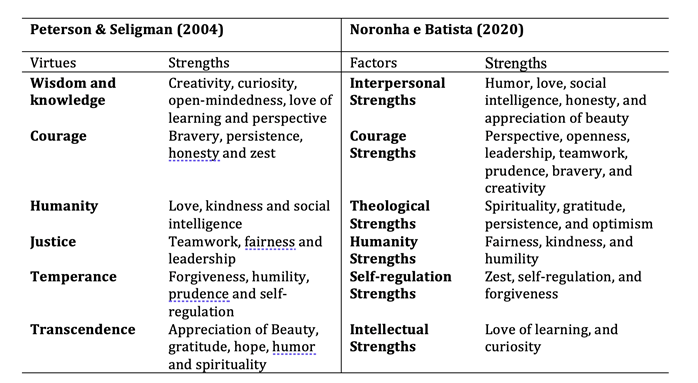
Studies were also conducted to search for evidence of validity with external variables related constructs such as personality, parenting styles, and social support. The personality factors of Extroversion and Socialization were more explanatory of personal strengths. Regarding parenting styles, strengths were more strongly associated with responsiveness, which interprets affection, involves sensitivity, acceptance, and commitment (Noronha & Batista, 2017, 2020; Noronha & Campos, 2018; Noronha & Reppold, 2019).
A recent theme concerning personal strengths revolves around differences in endorsement among different groups (e.g., men and women; adolescents and adults). Recent meta-analyses indicate that study findings are divergent regarding which strengths would be predominant among the mentioned groups (Heintz et al., 2019; Heintz & Ruch, 2022). However, before analyzing potential differences, it's necessary to investigate whether the instrument used to assess personal strengths measures the same construct across groups. In other words, if the instrument is invariant among them (Damásio, 2013).
Invariance analysis can be performed using three models, namely, (1) Configural, which indicates whether the number of factors and the number of items per factor are suitable for both groups; (2) Metric, which indicates the equivalence of item factor loadings between groups; (3) Scalar, which indicates that intercepts (the level of latent trait needed to endorse item categories) are equivalent across groups. Thus, if invariance is not accepted, for example, when comparing the means of men and women in the construct, the researcher may find a difference between sexes explained by measurement error rather than a genuine difference in the construct between them (Fischer & Karl, 2019; Peixoto & Martins, 2021).
Thus, the present study has the following objectives: (1) to test the factor structure of the EFC in the 6-factor model found by Noronha and Batista (2020) using CFA, seeking evidence of validity based on the internal structure of the construct (AERA et al., 2014); (2) to test the invariance of the EFC between adolescents and adults; (3) to test the invariance of the EFC between male and female adolescents; (4) to test the invariance of the EFC between men and women.
Method
Participants
The sample of this study consisted of 4,522 participants, aged between 13 and 65 years (M = 22.12; SD = 7.623), with 62.7 % reporting being female. Subsequently, for the invariance analysis of the scale between adult and adolescent genders, the sample was divided into two subsamples. The adult subsample consisted of 3,549 individuals, aged 18 to 65 years (M = 23.86; SD = 7.723), with 62.4 % reporting being female. The adolescent subsample consisted of 973 individuals, aged 13 to 17 years (M = 15.76; SD = 1.008), with 63.8 % reporting being female.
Instruments
Sociodemographic questionnaire. This questionnaire was developed for the current study aiming to collect information about the sex and age of the participants.
Character Strengths Scale (EFC; Noronha & Barbosa, 2016). The scale consists of 71 statements responded to on a five-point Likert scale (0 = not at all like me; 4 = very much like me). The instrument was developed to assess 24 personal strengths, organized into six virtues, according to Peterson and Seligman’s definition (2004). Each strength is represented by three items, except for the Appreciation of Beauty strength, which has only two. The result is calculated by summing the values of the responded items. The 6-factor model proposed by Noronha and Batista (2020) has good internal consistency indices: IS (α = .89); CS (α = .88); TS (α = .93); HS (α = .91); SRS (α = .83), and ITS (α = .88).
Procedures
The project was submitted to the Research Ethics Committee. After approval (No. 365.343), data collection was conducted in person (using pen and paper). The applications always took place on the premises of educational institutions, with minors being surveyed in schools and adults in universities. Participants over 18 years old signed the Informed Consent Form (ICF). For data collection in schools, after obtaining authorization from the principals, a schedule was established. Initially, the research objectives were explained, and the ICF was provided to parents. After receiving signed ICFs, collection times were scheduled. The applications took place during school hours, after obtaining the signed Informed Assent Form (IAF). For all participants, the questionnaires were presented in the following order: sociodemographic questionnaire and Character Strengths Scale. It was estimated that the form could be completed in approximately 20 minutes.
Data analysis
To evaluate the factorial structure of the scale, a Confirmatory Factor Analysis (CFA) was conducted using R software (R Core Team, 2022), through the Lavaan package (Rosseel, 2012), with the weighted least square mean and variance adjusted (WLSMV) estimation method (Asparouhov & Muthén, 2010). Model fit was assessed using the following indices: χ², degrees of freedom (df), Root Mean Squared Error of Approximation (RMSEA), Standardized Root Mean Residual (SRMR), Comparative Fit Index (CFI), and Tucker-Lewis Index (TLI). These indices are considered adequate when RMSEA and SRMR values are < .08 and CFI and TLI values are > .90, preferably > .95 (Hu & Bentler, 1999).
Next, the measurement invariance of each of the factors of the EFC between adults and adolescents was estimated using Multi-Group Confirmatory Factor Analysis (MG-CFA). We chose to perform the factor-by-factor invariance test, considering each factor as a unidimensional construct, precisely because each of them has a unique interpretability and has evidence of validity to support it.
The analysis was conducted using the statistical software R (R Core Team, 2022), and the weighted least square mean and variance adjusted (WLSMV) estimation method was employed (Asparouhov & Muthén, 2010). Scale invariance was evaluated in three models: configural (factorial structure), metric (factor loadings), and scalar (item intercepts). The assessment of invariance is conducted hierarchically, meaning that the more complex model is only evaluated if its predecessor is invariant (Peixoto & Martins, 2021).
To assess configural invariance, the same fit indices criteria from the CFA are considered. However, for metric and scalar invariance evaluation, the variability of CFI, RMSEA, and SRMR indices is considered. Worsening of ΔCFI ≤ 0.01, ΔRMSEA ≥ 0.015, and ΔSRMR ≥ 0.01 between a model and its predecessor indicate non-invariance. ΔCFI is considered the most robust index for assessing group invariance (Cheung & Rensvold, 2002); however, ΔRMSEA and ΔSRMR can be used as supplementary indices (Chen, 2007). Then, as previously mentioned, the sample was divided into two subsamples, one comprising adults and the other adolescents. Subsequently, using the same aforementioned procedure, invariance between sexes in both developmental stages was assessed.
Results
The results of the CFA conducted on the EFC are presented in Table 2 2a. As it is possible to observe, only item 3 did not obtain a satisfactory factor loading (≥ .30) on its respective factor (FC). The item relates to the strength of creativity (I do things in different ways).
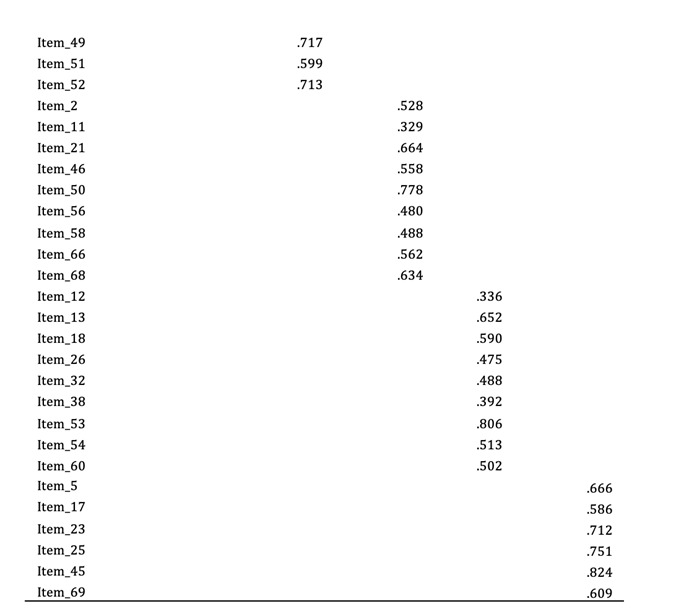
Note: IS = Interpersonal Strengths; CS = Courage Strengths; TS = Theological Strengths; HS = Humanity Strengths; SRS = Self-Regulation Strengths; ITS = Intellectual Strengths
The fit indices obtained in the CFA of the EFC were acceptable (χ² = 55127.615; df = 2399; RMSEA = .076; SRMR = .071; TLI = .909; CFI = .912). Due to item 3 not exhibiting a satisfactory factor loading, a new CFA excluding it was conducted, but no significant changes were found in the fit indices (χ² = 601118.791; df = 2415; RMSEA = .076 (90 % CI = .075-.076); SRMR = .071; TLI = .910; CFI = .913). Therefore, it was decided to retain item 3 for subsequent analyses. Regarding the internal consistency of the factors, all obtained good reliability indices: IS (α = .79; ω = .82); CS (α = .84; ω = .86); TS (α = .87; ω = .89); HS (α = .75; ω = .78); SRS (α = .73; ω = .80); ITS (α = .80; ω = .85). The lower alphas were found in the SRS and HS factors.
In order to address the second objective of this study, the results obtained from the invariance analysis between adolescents and adults are presented in Table 3. As can be observed, the results indicate, based on all considered indices, the configural, metric, and scalar invariance of the CS, TS, and ITS factors. This means that these factors showed strong equivalence between the groups, indicating that adolescents and adults respond similarly to the items of these factors.
In the case of the IS and HS factors, they exhibited configural and metric invariance across all indices. However, for the scalar model, the obtained ΔCFI (-.012) exceeded the proposed criterion (-.010), while the ΔRMSEA and ΔSRMR were acceptable. Although ΔCFI is considered the most robust index for assessing invariance, it exceeded the proposed criterion by only -.002. Therefore, it is possible to consider that both supplementary indices indicated the metric level of invariance. From this perspective, these factors can also be considered to have strong equivalence between adolescents and adults. Lastly, regarding the SRS factor, it did not exhibit acceptable fit indices in the configural model. Therefore, it cannot be considered equivalent across age groups in any of the models.
Table 3: Fit indices of the invariance models for the factors of the EFC tested between adolescents and adults
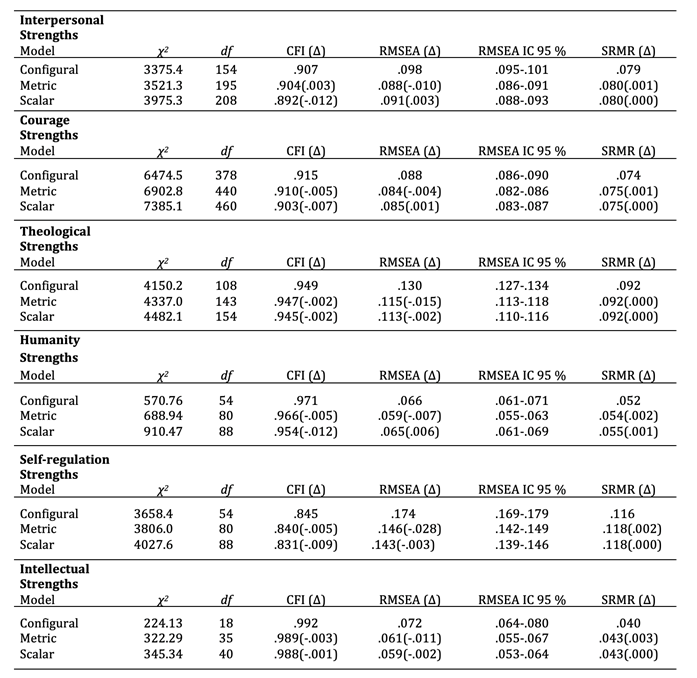
The results obtained from the sex invariance analysis in the adolescent subsample are presented in Table 4. As observed, only the TS factor exhibited invariance across all three models (Configural, Metric, and Scalar). The IS, HS, and ITS factors showed configural invariance. However, the CS and SRS factors did not exhibit invariance. Thus, it can be concluded that only the Theological Strengths factor demonstrates strong invariance between male and female adolescents.
Table 4: Fit indices of the invariance models for the factors of the EFC tested between sexes in adolescents
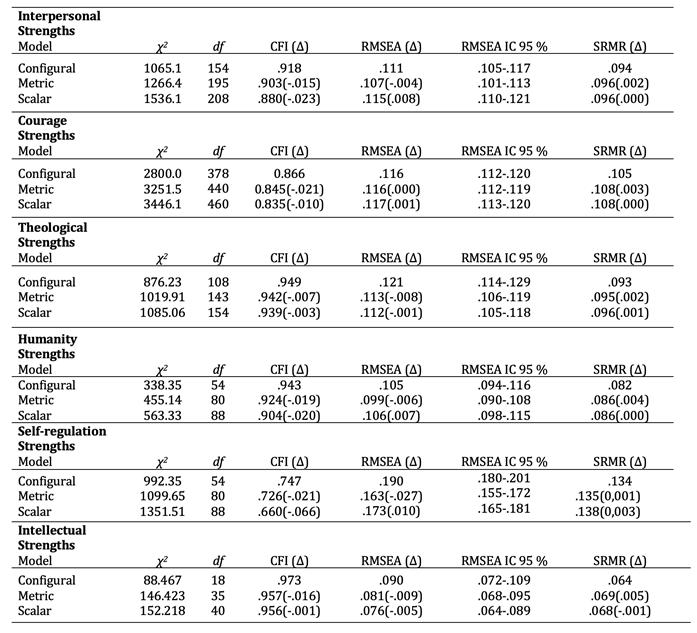
The results of the sex invariance analysis in the adult subsample are presented in Table 5. As observed, the CS, TS, HS, and ITS factors exhibited invariance across all three models (Configural, Metric, and Scalar), indicating strong invariance between the groups. In contrast, the IS and SRS factors did not exhibit invariance in any of the models.
Table 5: Fit indices of the invariance models for the factors of the EFC tested between sexes in adults
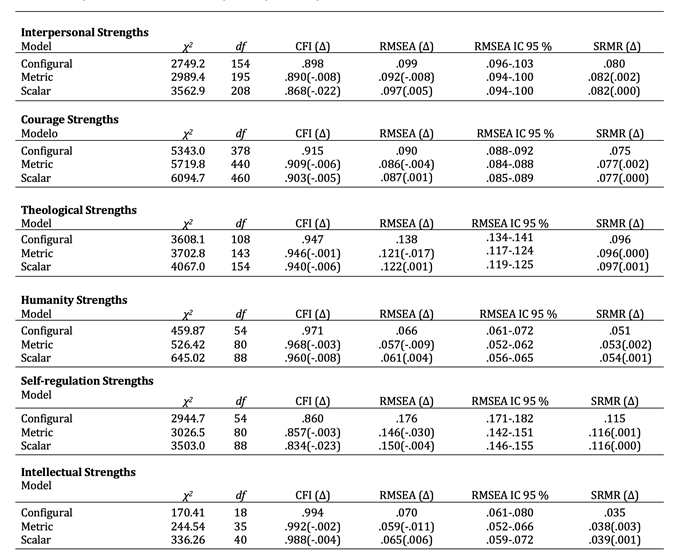
Table 6 presents a synthesis of the results of the invariance analyses of the six EFC factors. It displays, separately, the accepted invariance models for each of the scale factors in the three analyzed situations (between adolescents and adults, between sexes in adolescents, and between sexes in adults).
Discussion
The present study aimed to replicate the internal structure of the Character Strengths Scale proposed by Noronha and Batista (2020), seeking validity evidence based on internal structure. Although the instrument has undergone other studies of internal structure analysis (Noronha & Batista, 2020; Noronha et al., 2015; Noronha & Zanon, 2018), as advocated by AERA et al. (2014), new validity evidence should be sought with distinct samples. In this study, a broad sample was used. Additionally, the study sought to assess whether the factors found, when considered as unidimensional scales (due to the interpretability of each of them and the repeated validity evidence), demonstrated invariance between adolescents and adults and between the sexes within these groups.
Regarding the findings of the internal structure analysis, the indices were acceptable, thus replicating the study by Noronha and Batista (2020). The fit indices remained within the minimum parameters suggested by Hu and Bentler (1999), with all items except item 3 having factor loadings > .30 on their respective factors. Additionally, all factors of the instrument demonstrated good internal consistency (Cronbach, 1951). These results are consistent with other studies (Littman-Ovadia & Lavy, 2012; McGrath, 2014; Neto et al., 2014; Ng et al., 2016; Noronha & Batista, 2020; Noronha et al., 2015; Noronha & Zanon, 2018; Solano & Cosentino, 2018) indicating a distribution of personal strengths diverging from the theoretical model proposed by Peterson and Seligman (2004).
In discussing the instrument’s invariance analysis, it’s essential to highlight the importance of this type of procedure before making comparisons between groups. As discussed, the literature indicates discrepancies in which personal strengths have higher and lower means between men and women and between adolescents and adults (Heintz et al., 2019; Heintz & Ruch, 2022). However, the differences found may not reflect real differences in strengths between groups but may instead be due to errors or biases in the instrument’s measurement. Instruments with erroneous or biased measurements may not only point to non-existent differences but may also obscure existing differences between groups. precisely because it can shed light on this issue, evaluating the instrument’s invariance is extremely relevant (Chen, 2008).
In the present study, we conducted invariance analysis on the configural, metric, and scalar models. For understanding, the configural model assesses whether the instrument’s structure, i.e., its configuration, is adequate for both analyzed groups. When invariance is not accepted in this model, it means that the items load on different factors for each group. The metric model assesses whether the factor loadings of the items are statistically equal for both groups. When this is not accepted, it means that the items do not have the same importance for the instrument in both groups, indicating bias in responses to the items by one of the groups; hence, any mean comparison will be biased. Lastly, the scalar model assesses whether the latent trait level to respond to a certain item is equivalent between groups. When this is not accepted, it means that one of the groups may endorse an item more easily than the other (Damásio, 2013; Milfont & Fischer, 2010).
Thus, according to the description of the models, it becomes evident that comparative studies between genders, different age groups, and different nationalities are capable of reflecting real differences or similarities between the groups if the instrument used is equivalent across the groups. After all, the invariance accepted in the configural model pertains to the correct configuration of items in the model, and the invariance in the metric model only indicates that the factor loadings are statistically equivalent, while the invariance in the scalar model indicates that the items truly assess the latent trait of individuals belonging to both groups in an equivalent manner. Therefore, despite the relevance of each evaluated model, direct and unbiased comparisons between groups due to measurement error are only possible when all three levels of invariance are accepted (Fischer & Karl, 2019; Milfont & Fischer, 2010).
In the present study, scalar equivalence of the EFC was accepted between adolescents and adults in the IS, CS, TS, HS, and ITS factors, between male and female adolescents in the TS factor, and between men and women in the CS, TS, HS, and ITS factors. As explained, these results suggest that mean comparisons in personal strengths between the groups are possible in those belonging to these aforementioned factors (e.g., humor between adolescents and adults; spirituality between male and female adolescents; prudence between men and women). Therefore, it can be stated that comparisons between character strengths belonging to factors that did not achieve scalar invariance between the evaluated groups are not possible, as they will not reflect real differences or similarities but rather errors and biases in the measurement instrument (Damásio, 2013; Fischer & Karl, 2019; Peixoto & Martins, 2021).
It is relevant to highlight that the SRS factor did not achieve configural invariance in any of the pairs of groups tested. Upon carefully investigating the results of the model, it was observed that some items behaved differently between the groups. In the comparison between adolescents and adults, item 60 (“I am a careful person”) obtained a factor loading < .30 for both groups. However, items 18 (“I always have a lot of energy”) and 53 (“I feel full of life”) had higher loadings for adults than for adolescents; this may indicate that, perhaps, for some adolescents, these items are not directly related to other self-regulation items but to other characteristics of their personality. In the comparison between genders in adolescents, items 18, 60, and 38 (“I remain calm even in difficult situations”) loaded adequately on the factor only for the female group. Previous studies have shown that female adolescents tend to score higher in self-regulation than male adolescents (Coyne et al., 2015; Sanchis-Sanchis et al., 2020; Tetering et al., 2020), so it is possible that the lack of configural invariance between groups is due to this difference. Regarding the comparison between genders in adults, item 60 had a very low factor loading for the male group (.167), and item 38 had a higher loading for women than for men. Both items involve questions related to calmness/care, and as the literature suggests, women tend to report more self-regulation strategies than men (Nolen-Hoeksema, 2012), which may justify the lack of invariance of this factor between groups.
The CS factor was also not invariant even at the configural level between the groups of adolescents. An observation of the factor loadings indicated that items 3 (“I do things in different ways”), 6 (“I make good judgments even in difficult situations”), 7 (“I think about different possibilities when making a decision”), 29 (“I think a lot before making a decision”), and 36 (“I analyze what people say before giving my opinion”) obtained loadings < .30 for the male adolescent group. Unlike items such as 35 (“I face dangers to do good”) which more directly reflect a positively oriented courage, the content of these items involves something closer to thinking/reflecting before acting. Therefore, it is possible that for the male adolescent group, these items are capturing a different type of content such as impulsivity control (Weinstein & Dannon, 2015).
Finally, the IS factor did not exhibit configural invariance between genders for adults. Item 10 (“I do not lie to please people”) obtained a factor loading < .30 for men (.222), but it also did not have a very high loading for women (.317). Because it is a positive item (in terms of the latent trait), but contains the word “not”, participants may have had difficulty interpreting the meaning of the sentence, which may have penalized the fit of the configural model and resulted in the non-invariance of the factor. However, item 33 (“I am a truthful person”) also showed a higher loading for women than for men, which may indicate that there may indeed be a difference in the functioning of item content between genders in adults beyond the issue pointed out for item 10.
Final considerations
The structure found by Noronha and Batista (2020) for EFC was replicated in the present study. This brings a new indication that this distribution of personal forces is empirically supported. Although item 3 did not cause significant harm to the model fit, its reformulation might be considered due to its low factor loading. Specifically, the item refers to creativity (“I do things in different ways”), and it is possible that the meaning of doing things differently has various interpretations, which may have impacted the results. It is unique that further studies be conducted, including additional applications of pilot studies.
Regarding factor invariance, the results indicated that only the TS factor exhibited scalar invariance across all group comparisons. However, in at least one group comparison, the other factors demonstrated complete invariance, except for the SRS factor, which was non-invariant in all group comparisons. This may suggest a prioritized revision of the items composing the SRS factor. The CS and IS factors also warrant attention in a future instrument revision, as the former did not function equivalently at any level between sex groupings in adolescents, and the same occurred with the latter in adults.
As a limitation of the present study, it can be noted that due to the number of items allocated for each character strength being less than four, it was not possible to assess the invariance of these strengths individually through MG-CFA (Czerwiński & Atroszko, 2021). It is recommended that future studies employ methods capable of evaluating the invariance of each strength separately.
REFERENCES
American Educational Research Association, American Psychological Association, & National Council on Measurement in Education. (2014). Standards for Educational and Psychological Testing: National Council on Measurement in Education. American Educational Research Association. [ Links ]
Asparouhov, T., & Muthén, B. (2010). Simple Second Order Chi-Square Correction. https://www.statmodel.com/download/WLSMV_new_chi21.pdf [ Links ]
Chen, F. F. (2007). Sensitivity of Goodness of Fit Indexes to Lack of Measurement Invariance. Structural Equation Modeling: A Multidisciplinary Journal, 14(3), 464-504. https://doi.org/10.1080/10705510701301834 [ Links ]
Chen, F. F. (2008). What happens if we compare chopsticks with forks? The impact of making inappropriate comparisons in cross-cultural research. Journal of Personality and Social Psychology, 95(5), 1005. https://doi.org/10.1037/a0013193 [ Links ]
Cheung, G. W., & Rensvold, R. B. (2002). Evaluating Goodness-of-Fit Indexes for Testing Measurement Invariance. Structural Equation Modeling: A Multidisciplinary Journal, 9(2), 233-255. https://doi.org/10.1207/S15328007SEM0902_5 [ Links ]
Coyne, M. A., Vaske, J. C., Boisvert, D. L., & Wright, J. P. (2015). Sex differences in the stability of self-regulation across childhood. Journal of Developmental and Life-Course Criminology, 1(1), 4-20. https://doi.org/10.1007/s40865-015-0001-6 [ Links ]
Cronbach, L. J. (1951). Coefficient alpha and the internal structure of tests. Psychometrika, 16, 297-334. https://doi.org/10.1007/BF02310555 [ Links ]
Czerwiński, S. K., & Atroszko, P. A. (2023). A solution for factorial validity testing of three-item scales: An example of tau-equivalent strict measurement invariance of three-item loneliness scale. Current Psychology, 42(2), 1652-1664. https://doi.org/10.1007/s12144-021-01554-5 [ Links ]
Damásio, B. F. (2013). Contribuições da Análise Fatorial Confirmatória Multigrupo (AFCMG) na avaliação de invariância de instrumentos psicométricos. Psico-Usf, 18, 211-220. https://doi.org/10.1590/S1413-82712013000200005 [ Links ]
Fischer, R., & Karl, J. A. (2019). A Primer to (Cross-Cultural) Multi-Group Invariance Testing Possibilities in R. Frontiers in Psychology, 10, 1507. https://doi.org/10.3389/fpsyg.2019.01507 [ Links ]
Heintz, S., Kramm, C., & Ruch, W. (2019). A meta-analysis of gender differences in character strengths and age, nation, and measure as moderators. The Journal of Positive Psychology, 14(1), 103-112. https://doi.org/10.1080/17439760.2017.1414297 [ Links ]
Heintz, S., & Ruch, W. (2022). Cross-sectional age differences in 24 character strengths: Five meta-analyses from early adolescence to late adulthood. The Journal of Positive Psychology, 17(3), 356-374. https://doi.org/10.1080/17439760.2021.1871938 [ Links ]
Hu, L. T., & Bentler, P. M. (1999). Cutoff criteria for fit indexes in covariance structure analysis: Conventional criteria versus new alternatives. Structural Equation Modeling, 6(1), 1-55. https://doi.org/10.1080/10705519909540118 [ Links ]
Littman-Ovadia, H., & Lavy, S. (2012). Character strengths in Israel Hebrew adaptation of the VIA Inventory of Strengths. European Journal of Psychological Assessment, 28(1), 41-50. https://doi.org/10.1027/1015-5759/a00008 [ Links ]
McGrath, R. E. (2014). Measurement Invariance in Translations of the VIA Inventory of Strengths. European Journal of Psychological Assessment, 32(3), 187-194. http://doi.org/10.1027/1015-5759/a000248 [ Links ]
Milfont, T. L., & Fischer, R. (2010). Testing measurement invariance across groups: Applications in cross-cultural research. International Journal of Psychological Research, 3(1), 111-130. https://doi.org/10.21500/20112084.857 [ Links ]
Neto, J., Neto, F., & Furnham, A. (2014). Gender and Psychological Correlates of Self-rated Strengths Among Youth. Social Indicators Research, 118(1), 315-327. http://doi.org/10.1007/s11205-013-0417-5 [ Links ]
Ng, V., Cao, M., Marsh, H. W., Tay, L., & Seligman, M. E. P. (2016). The factor structure of the Values in Action Inventory of Strengths (VIA-IS): An item-level Exploratory Structural Equation Modeling(ESEM) bifactor analysis. Psychological Assessment, 29(8). http://doi.org/10.1037/pas0000396 [ Links ]
Nolen-Hoeksema, S. (2012). Emotion regulation and psychopathology: The role of gender. Annual Review of Clinical Psychology, 8(1), 161-187. https://doi.org/10.1146/annurev-clinpsy-032511-143109 [ Links ]
Noronha, A. P. P., & Barbosa, A. J. C. (2016). Forças e Virtudes: Escala de Forças de Caráter. Em C. S. Hutz (Ed.), Avaliação em Psicologia Positiva: Técnicas e Medidas (pp. 21-43). CETEPP. [ Links ]
Noronha, A. P. P., & Batista, H. H. V. (2017). Escala de Forças e Estilos Parentais: Estudo correlacional. Estudos Interdisciplinares em Psicologia, 8(2), 2-19. https://doi.org/10.5433/2236- 6407.2017v8n2p02 [ Links ]
Noronha, A. P. P., & Batista, H. H. V. (2020). Análise da estrutura interna da Escala de Forças de Caráter. Ciencias Psicológicas, 14(1), e-2150. https://doi.org/10.22235/cp.v14i1.2150 [ Links ]
Noronha, A. P. P., & Campos, R. R. F. (2018). Relationship between character strengths and personality traits. Estudos de Psicologia, 35(1), 29-37. https://doi.org/10.1590/1982- 02752018000100004 [ Links ]
Noronha, A. P. P., Dellazzana-Zanon, L. L., & Zanon, C. (2015). Internal structure of the Characters Strengths Scale in Brazil. Psico-USF, 20(2), 229-235. https://doi.org/10.1590/1413-82712015200204 [ Links ]
Noronha, A. P. P., & Reppold, C. T. (2019). Introdução às forças de caráter. Em M. N. Baptista (Ed.), Compêndio de Avaliação Psicológica, (pp. 549-568). Vozes. [ Links ]
Noronha, A. P. P., & Reppold, C. T. (2021). As fortalezas dos indivíduos: o que são forças de caráter? Em M. Rodrigues, & D. da S.Pereira (Eds.), Psicologia Positiva: dos conceitos à aplicação, (Vol. 1, pp. 68-81). Sinopsys. [ Links ]
Noronha, A. P. P., & Zanon, C. (2018). Strenghts of character of personal growth: Structure and relations with the big five in the Brazilian context. Paidéia (ribeirão Preto), 28, e2822 https://doi.org/10.1590/1982-4327e2822 [ Links ]
Park, N. (2009). Character Strength. Em S. J. Lopez (Ed.), The encyclopedia of positive psychology, (pp. 135-141). Blackwell. [ Links ]
Peixoto, E. M., & Martins, G. H. (2021). Contribuições da análise fatorial confirmatória para a validade de instrumentos psicológicos. Em C. Faiad, Baptista M. B., & Primi, R., Tutoriais em análise de dados aplicados à psicometria (pp. 143-160). Vozes. [ Links ]
Peterson, C., & Seligman, M. E. (2004). Character strengths and virtues: A handbook and classification (Vol. 1). Oxford University Press. [ Links ]
R Core Team. (2022). R: A language and environment for statistical computing. R Foundation for Statistical Computing. [ Links ]
Reppold, C., D’Azevedo, L., & Noronha, A. P. P. (2021). Estratégias de avaliação de forças de caráter. Psicologia, Saúde & Doenças, 22(1), 50-61. https://doi.org/10.15309/21psd220106 [ Links ]
Rosseel, Y. (2012). lavaan: An R Package for Structural Equation Modeling . Journal of Statistical Software, 48(2). https://doi.org/10.18637/jss.v048.i02 [ Links ]
Seibel, B. L., DeSousa, D., & Koller, S. H. (2015). Adaptação brasileira e estrutura fatorial da escala 240-item VIA Inventory of Strengths. Psico-USF, 20, 371-383. https://doi.org/10.1590/1413-82712015200301 [ Links ]
Sanchis-Sanchis, A., Grau, M. D., Moliner, A.-R., & Morales-Murillo, C. P. (2020). Effects of age and gender in emotion regulation of children and adolescents. Frontiers in Psychology, 11, 946. https://doi.org/10.3389/fpsyg.2020.00946 [ Links ]
Solano, A. C., & Cosentino, A. C. (2018). IVyF abreviado -IVyFabre-: análisis psicométrico y de estructura factorial en Argentina. Avances en Psicología Latinoamericana/Bogotá (Colombia ), 36(3), 619-637. https://doi.org/10.12804/revistas.urosario.edu.co/apl/a.4681 [ Links ]
Tetering, M. A. J. van, Laan, A. M. van der, Kogel, C. H. de, Groot, R. H. M. de, & Jolles, J. (2020). Sex differences in self-regulation in early, middle and late adolescence: A large-scale cross-sectional study. PLOS ONE, 15(1), e0227607. https://doi.org/10.1371/journal.pone.0227607 [ Links ]
Weinstein, A., & Dannon, P. (2015). Is impulsivity a male trait rather than female trait? Exploring the sex difference in impulsivity. Current Behavioral Neuroscience Reports, 2(1), 9-14. https://doi.org/10.1007/s40473-015-0031-8 [ Links ]
How to cite: Rocha, R. M. A. da, Santos, C. G., Gonzalez, H. V., & Noronha, A. P. P. (2024). Character Strengths Scale: new validity evidence. Ciencias Psicológicas, 18(1), e-3297. https://doi.org/10.22235/cp.v18i1.3297
Authors’ contribution (CRediT Taxonomy): 1. Conceptualization; 2. Data curation; 3.Formal Analysis; 4. Funding acquisition; 5. Investigation; 6. Methodology; 7. Project administration; 8. Resources; 9. Software; 10. Supervision; 11. Validation; 12. Visualization; 13. Writing: original draft; 14. Writing: review & editing R. M. A. D. R has contributed in 1, 2, 3, 6, 12, 13; C. G. S. in 1, 6, 12, 13; H. V. G. in 1, 6, 12, 13; A. P. P. N. in 1, 6, 7, 10, 12, 13, 14.
Received: March 21, 2023; Accepted: March 06, 2024











 texto en
texto en 


